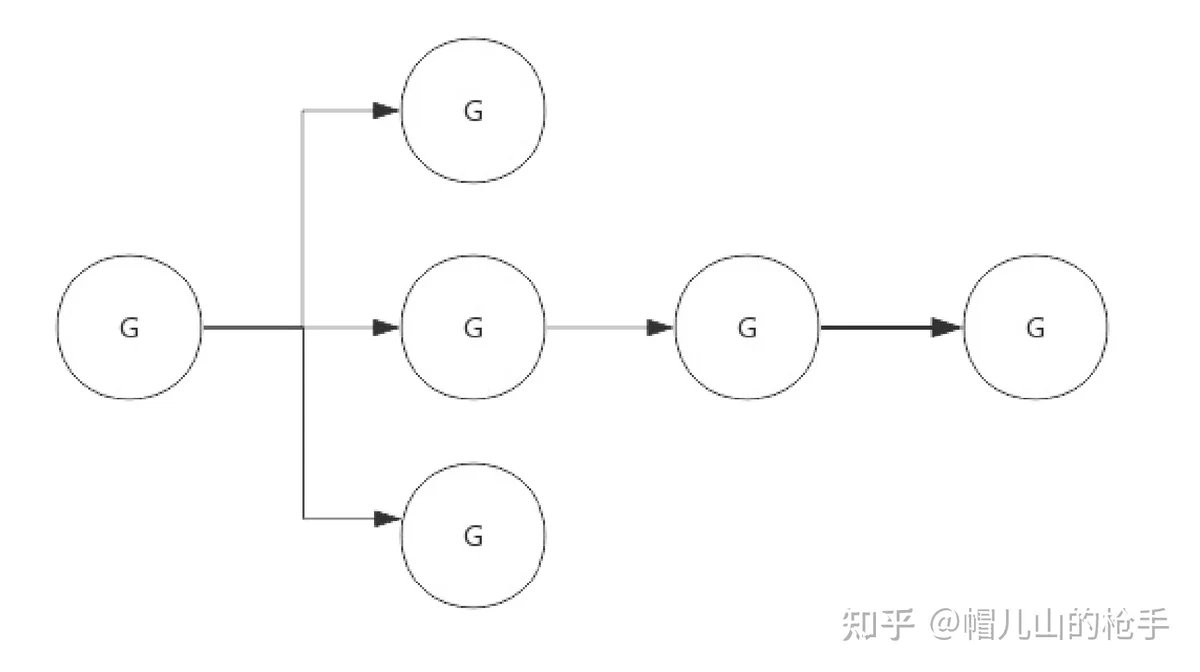大家好,今天将梳理出的 Go语言中 context 标准库内容,分享给大家。 请多多指教,谢谢。
本章节内容
- context 介绍
- context 类型
- context 函数
- 示例
context 介绍
context 翻译成中文是 上下文 的意思,它可以对 API 和进程之间传递截止日期、取消信号和其他请求范围的值。
使用上下文的程序应遵循以下规则:
- 保持包之间的接口一致
- 不要在结构类型中存储上下文
- 上下文应该是第一个参数,通常命名为ctx
- 上下文值仅用于传输进程和API的请求范围数据,而不用于向函数传递可选参数
sync.WaitGroup相同的上下文可以传递给在不同 goroutine 中运行的函数,上下文对于多个 goroutine 同时使用是安全的。它可以控制一组呈树状结构的 goroutine,经典的使用场景如下图所示:

sync.WaitGroupgoroutineContext 实际上只定义了接口,凡是实现该接口的类都可称为是一种 context,官方包实现了几个常用的context,分别可用于不同的场景。
context 类型
空 context
context包中定义了一个空的context,名为emptyCtx,用于 context 的根节点,空的 context 只是简单的实现了 context,本身不包含任何值,仅用于其他 context 的父节点。
如下代码可查看 go源码中 go/src/context/context.go 文件
emptyCtx类型源码定义:
// emptyCtx不会被取消,没有值,也没有截止日期。它不是struct{},因为这种类型的变量必须有不同的地址。
type emptyCtx int
func (*emptyCtx) Deadline() (deadline time.Time, ok bool) {
return
}
func (*emptyCtx) Done() <-chan struct{} {
return nil
}
func (*emptyCtx) Err() error {
return nil
}
func (*emptyCtx) Value(key any) any {
return nil
}
func (e *emptyCtx) String() string {
switch e {
case background:
return "context.Background"
case todo:
return "context.TODO"
}
return "unknown empty Context"
}
CancelFunc 类型原型
// CancelFunc类型是一个停止工作的方法
// CancelFunc不会等待工作停止
// CancelFunc可以被多个goroutine同时调用, 在第一次调用之后, 对CancelFunc的后续调用什么也不做
type CancelFunc func()
Context 类型原型
type Context interface {
// Deadline返回的时间是代表该上下文所做的工作应该被取消的时间。如果没有设置截止日期,则返回ok==false。连续调用Deadline会返回相同的结果。
Deadline() (deadline time.Time, ok bool)
// Done返回一个channel通道,该通道代表完成工作时关闭取消上下文。需要在 select-case 语句中使用, case <-context.Done():
// 如果上下文未关闭,Done返回nil。
// 当context关闭后, Done返回一个被关闭的通道, 关闭仍然是可读的, goroutine可以接收到关闭请求
// 连续调用Done将返回相同的值。Done通道的关闭可能会异步发生,当cancel函数返回。
// 参考 https://blog.golang.org/pipelines 更多的示例
Done() <-chan struct{}
// 该方法描述 context 关闭的原因
// 如果Done未关闭,Err返回nil。
// 如果Done被关闭,Err返回一个非nil错误
Err() error
// 该方法根据 key 值查询map中 value
// Value返回与此上下文关联的Value for key,或nil 如果没有value与key相关联。连续调用Value相同的键返回相同的结果。
Value(key any) any
}
Context 一般携带一个截止日期、一个取消信号和其他跨越API边界的值。上下文的方法可以被多个 goroutine 同时调用。
Background() 方法原型
var background = new(emptyCtx)
func Background() Context{
return background
}
Background 函数返回一个非nil的空Context。它永远不会被取消,没有价值,也没有期限。它通常由主函数、初始化和测试使用,并作为传入请求的顶级上下文。
TODO() 方法原型
var todo = new(emptyCtx)
func TODO() Context {
return todo
}
TODO 函数返回一个非nil的空Context。代码应该使用上下文。当不清楚要使用哪个Context或者它还不可用时(因为周围的函数还没有扩展到接受Context参数)。
WithValue() 方法原型
func WithValue(parent Context, key, val any) Context
WithValue 函数,返回父对象的副本,其中与键关联的值为val。
上下文值只用于传递进程和api的请求范围内的数据,而不是传递可选参数给函数。
{}struct{}context 函数
WithCancel() 函数原型
func WithCancel(parent Context) (ctx Context, cancel CancelFunc) {
if parent == nil {
panic("cannot create context from nil parent")
}
c := newCancelCtx(parent)
propagateCancel(parent, &c)
return &c, func() { c.cancel(true, Canceled) }
}
Done()Done()Done()取消此上下文将释放与其关联的资源,因此在此上下文中运行的操作完成后,代码应立即调用cancel。
示例
这个例子演示了如何使用可取消上下文来防止 goroutine 泄漏。在示例函数的末尾,由 gen 启动的 goroutine 将返回而不会泄漏。
package main
import (
"fmt"
"context"
)
func main() {
gen := func(ctx context.Context) <-chan int {
dst := make(chan int)
n := 1
go func() {
for {
select {
case <-ctx.Done():
return // 结束 goroutine 运行
case dst <- n:
n++
}
}
}()
return dst
}
ctx, cancel := context.WithCancel(context.Background())
defer cancel() // 消耗完时取消
for n := range gen(ctx) {
fmt.Println(n)
if n == 5 {
break
}
}
}
输出
1
2
3
4
5WithDeadline() 函数原型
func WithDeadline(parent Context, d time.Time) (Context, CancelFunc) {
if parent == nil {
panic("cannot create context from nil parent")
}
if cur, ok := parent.Deadline(); ok && cur.Before(d) {
// The current deadline is already sooner than the new one.
return WithCancel(parent)
}
c := &timerCtx{
cancelCtx: newCancelCtx(parent),
deadline: d,
}
propagateCancel(parent, c)
dur := time.Until(d)
if dur <= 0 {
c.cancel(true, DeadlineExceeded) // deadline has already passed
return c, func() { c.cancel(false, Canceled) }
}
c.mu.Lock()
defer c.mu.Unlock()
if c.err == nil {
c.timer = time.AfterFunc(dur, func() {
c.cancel(true, DeadlineExceeded)
})
}
return c, func() { c.cancel(true, Canceled) }
}
WithDeadline(parent, d)Done()取消此上下文将释放与其关联的资源,因此在此上下文中运行的操作完成后,代码应立即调用cancel。
示例
这个例子传递了一个带有任意截止日期的上下文,告诉阻塞函数一旦到达该函数就应该结束它的工作。
package main
import (
"fmt"
"context"
"time"
)
const shortDuration = 1 * time.Millisecond
func main() {
d := time.Now().Add(shortDuration)
ctx, cancel := context.WithDeadline(context.Background(), d)
defer cancel()
select {
case <-time.After(1 * time.Second):
fmt.Println("在截止时间之后停止")
case <-ctx.Done():
fmt.Println("在截止时间停止")
}
}
输出
在截止时间停止WithTimeout() 函数原型
func WithTimeout(parent Context, timeout time.Duration) (context, CancelFunc)
WithDeadline(parent, time.Now().add(timeout))取消这个上下文会释放与之相关的资源,所以只要在这个上下文中运行的操作完成,代码就应该调用cancel:
func slowOperationWithTimeout(ctx context.Context) (Result, error) {
ctx, cancel := context.WithTimeout(ctx, 100*time.Millisecond)
defer cancel() // 如果slowOperation在超时之前完成,则释放资源
return slowOperation(ctx)
}
示例
这个例子传递了一个带有超时的上下文,告诉阻塞函数在超时过后应该放弃它的工作。
package main
import (
"fmt"
"context"
"time"
)
const shortDuration = 1 * time.Millisecond
func main() {
ctx, cancel := context.WithTimeout(context.Background(), shortDuration)
defer cancel()
select {
case <-time.After(1 * time.Second):
fmt.Println("在超时时间之后结束")
case <-ctx.Done():
fmt.Println("在超时时间结束")
}
}
输出
在超时时间结束示例
context.WithValue()package main
import (
"fmt"
"context"
)
func main() {
type favContextKey string
f := func(ctx context.Context, k favContextKey) {
if v := ctx.Value(k); v != nil {
fmt.Println("found value:", v)
return
}
fmt.Println("key not found:", k)
}
key1 := favContextKey("key1")
ctx := context.WithValue(context.Background(), key1, "Golang")
f(ctx, key1)
f(ctx, favContextKey("key2"))
}
输出
found value: Golang
key not found: key2这个例子使用cancel context,管理派生 goroutine 的生命周期,代码如下所示
package main
import (
"fmt"
"context"
"time"
)
func HandleRequest(ctx context.Context) {
go WriteRedis(ctx)
go WriteDatabase(ctx)
for {
select {
case <-ctx.Done():
fmt.Println("HandleRequest Done.")
return
default:
fmt.Println("HandleRequest running.")
time.Sleep(2 * time.Second)
}
}
}
func WriteRedis(ctx context.Context) {
for {
select {
case <-ctx.Done():
fmt.Println("WriteRedis Done.")
return
default:
fmt.Println("WriteRedis running.")
time.Sleep(2 * time.Second)
}
}
}
func WriteDatabase(ctx context.Context){
for {
select {
case <-ctx.Done():
fmt.Println("WriteDatabase Done.")
return
default:
fmt.Println("WriteDatabase running.")
time.Sleep(2 * time.Second)
}
}
}
func main() {
ctx, cancel := context.WithCancel(context.Background())
go HandleRequest(ctx) // 父 goroutine
time.Sleep(5 * time.Second)
fmt.Println("5秒钟后, 关闭所有goroutine")
cancel()
time.Sleep(5 * time.Second) // 检查是否还有其他 goroutine 未关闭
}
输出
WriteRedis running.
WriteDatabase running.
HandleRequest running.
HandleRequest running.
WriteDatabase running.
WriteRedis running.
HandleRequest running.
WriteRedis running.
WriteDatabase running.
5秒钟后, 关闭所有goroutine
HandleRequest Done.
WriteDatabase Done.
WriteRedis Done.技术文章持续更新,请大家多多关注呀~~
搜索微信公众号,关注我【 帽儿山的枪手 】
参考资料
[1] context 标准库:
[2] 《Go专家编程》书籍:
